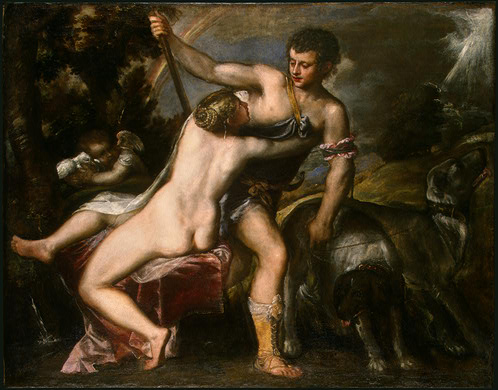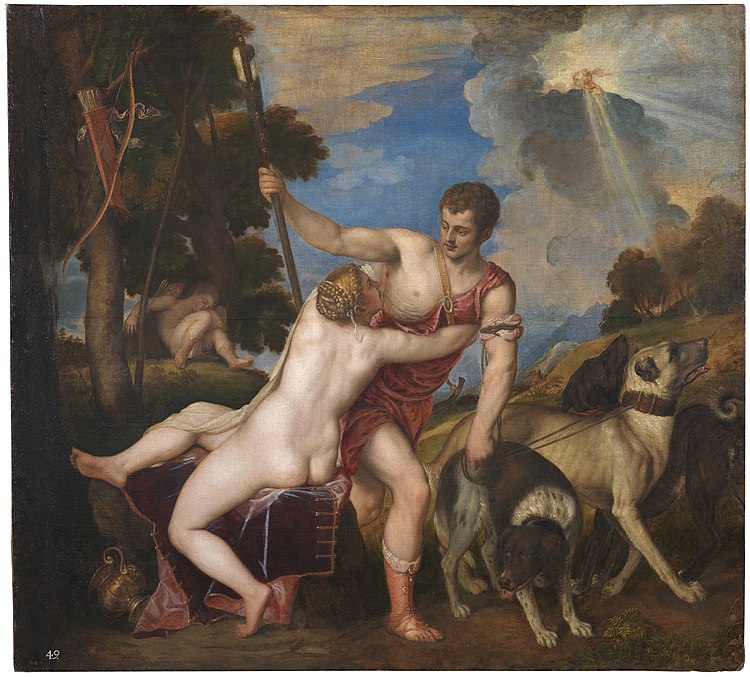Introduction:
Titian’s Venus and Adonis is an iconic masterpiece that showcases the artist’s unrivaled ability to capture the complexities of human emotion and the sublime beauty of the human form. The painting, created during the Italian Renaissance, has been revered for centuries for its exceptional composition, use of color, and narrative power. Two renowned versions of this painting exist, one housed at the Farnese Gallery in Rome (probably a lost version and there are 30 versions overall) and the other at the Prado Museum in Madrid. This essay will explore the similarities and differences between these two versions, shedding light on the distinct artistic choices made by Titian and the impact they have on our interpretation of the narrative.


Top – Farnese type Bottom: Prado type
- Composition and Scale: The Farnese version of Venus and Adonis presents a horizontal composition, with the figures arranged in a linear manner across the canvas. Venus, the goddess of love, occupies the left side, reclining sensuously on a bed of sumptuous fabrics. Adonis, the handsome mortal lover, stands on the right, dressed in hunting attire. The Prado version, on the other hand, adopts a more vertical composition. Venus and Adonis are brought closer together, emphasizing their physical proximity and emotional connection. This altered composition creates a more intimate atmosphere in the Prado version.
- Color Palette and Brushwork: Titian’s skillful use of color is evident in both versions of the painting. In the Farnese version, the color scheme leans towards warmer tones, with rich reds, golden yellows, and lush greens dominating the landscape. The colors evoke a sense of passion and vitality, reflecting the intense emotions associated with love and desire. In contrast, the Prado version exhibits a cooler palette, with a greater emphasis on blues and silvery hues. This cooler color scheme lends a more melancholic and contemplative mood to the scene, capturing the impending tragedy of Adonis’s fate.
- Emotional Expression and Narrative Depiction: One notable difference between the two versions lies in the portrayal of the characters’ emotions. In the Farnese Venus and Adonis, Venus’s face exudes a sense of longing, her eyes fixed on Adonis with a mix of desire and concern. Adonis, however, appears more detached, focusing his attention on his hunting dogs. This contrast highlights the tension between their respective desires and foreshadows the tragic outcome of their story. In the Prado version, both Venus and Adonis display heightened emotional intensity. Venus’s expression is anguished, her hand reaching out to prevent Adonis’s departure. Adonis, in turn, conveys a mixture of hesitation, resolve, and sorrow, enhancing the dramatic impact of the impending separation.
- Symbolism and Surrounding Elements: The surrounding elements in the two versions contribute to the narrative and symbolic context of the painting. In the Farnese version, a group of playful cupids hovers above Venus and Adonis, symbolizing the divine intervention that will ultimately lead to Adonis’s demise. Additionally, a landscape with a distant cityscape suggests the temporal nature of mortal existence. In the Prado version, the landscape is simplified, focusing attention on the emotional connection between the two figures. The absence of the cupids in the Prado version enhances the sense of impending tragedy, stripping away the divine intervention that offers a glimmer of hope in the Farnese version.
Conclusion: Both the Farnese and Prado versions of Titian’s Venus and Adonis are exceptional examples of the artist’s mastery in capturing the essence of human emotion and beauty. While the two paintings depict the same narrative, their differences in composition, color palette, emotional expression, and surrounding elements contribute to distinct interpretations and emotional impacts
